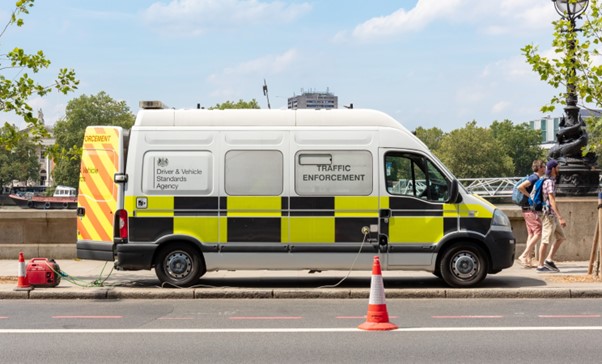
Susie Jones
Vysvětlení kontrol DVSA pro nákladní vozidla
Vytvořeno: 08.08.2024
•
Aktualizováno: 08.08.2024
Během své kariéry řidiče nákladního vozidla můžete být zastaveni Agenturou pro normy pro řidiče a vozidla (DVSA). Pro řidiče nákladních vozidel, kteří v oboru teprve začínají, to může být skličující proces. Pochopení základních aspektů kontrol DVSA u nákladních vozidel však může tento proces učinit méně stresujícím.
Kdo je DVSA?
Podle Gov.uk je DVSA zodpovědná za "provádění silničních kontrol komerčních řidičů a vozidel, aby se ujistila, že dodržují bezpečnostní pravidla a udržují své vozidlo bezpečné pro jízdu".
DVSA může provádět namátkové kontroly vašeho nákladního vozidla a vydávat zákazy. Zákazy brání řidiči nákladního vozidla v jízdě, dokud není problém s jeho vozidlem vyřešen.
Policie má rovněž pravomoc zastavit řidiče nákladního vozidla a provést podobnou kontrolu.
Jak vypadají examinátoři DVSA?
Zkoušejícího DVSA poznáte podle několika způsobů. Nosí žluté viditelné bundy s logem DVSA a vždy mají průkaz zkušebního komisaře. Jejich vozidla mají na kapotě černožlutý potisk s logem DVSA.

Co se stane, když vás zastaví?
Nezastavení na výzvu kontrolora DVSA je přestupek. Pokud vás zkušební komisař vyzve k zastavení, provede kontrolu na silnici nebo na vyhrazeném zkušebním místě. Hlavním účelem těchto zastavení je zabránit nebezpečným vozidlům v jízdě.
Zkoušející provede následující povinné kontroly:
Kontrolu povolené hmotnosti nákladu a typu nákladu.
Kontrola mechanických závad a technické způsobilosti k jízdě
Zajištění správnosti záznamů tachografu
Ujistěte se, že máte platný řidičský průkaz.
Jak dlouho trvá obchůzka DVSA?
Průměrně trvá obchůzková kontrola DVSA 15 minut. V případech, kdy nákladní vozidlo nesplňuje bezpečnostní požadavky, však může trvat déle. Examinátor musí provést nezbytné kontroly bez ohledu na čas.
Jak se ujistit, že je vaše vozidlo způsobilé k provozu na pozemních komunikacích
Řidič je povinen zajistit, aby jeho vozidlo bylo způsobilé k provozu na pozemních komunikacích. Před každou jízdou se doporučuje provést obchůzkovou kontrolu.
Zkontrolujte následující položky:
Světla
Indikátory
Palivo a olej
Pneumatiky
Upevnění kol
Práce na těle
Spojka přívěsu
Náklad a další vybavení
Kontrola vozidla v kabině (např. bezpečnostní pásy, klakson, stěrače, ostřikovače, řízení a ukazatel výšky).
Řidič nákladního vozidla je navíc povinen písemně oznámit své organizaci všechny závady. Ty by měly obsahovat následující údaje:
Registrační nebo identifikační značka vozidla
Datum kontroly
Podrobnosti o závadách
Jméno osoby, která závady hlásí.
Povinnosti operátora
Provozovatelé vozidel jsou odpovědní za zajištění bezpečnosti svých vozidel a musí provádět následující činnosti:
Provozovatel musí zajistit pravidelné bezpečnostní kontroly všech užitkových vozidel.
Musí zajistit, aby jejich řidiči pochopili, jaké kontroly je třeba provádět.
Zákazy u silnic
Pokud vaše nákladní vozidlo není způsobilé k provozu na pozemních komunikacích, může vám úřad DVSA vydat dvě různá oznámení o zákazu činnosti - okamžité nebo odložené.
Oznámení o okamžitém zákazu:
Může vstoupit v platnost okamžitě
Ve většině případů vede k odstavení vozidla.
Okamžité zákazy mohou vést k trestnímu stíhání.
Oznámení o odloženém zákazu:
Provozovatel má na vyřešení problémů až 10 dní.
Po deseti dnech policisté vozidlo znovu zkontrolují.
Před zahájením jízdy musí být zákazy odstraněny.
Zákazy technické způsobilosti
Pokud má nákladní vozidlo mechanické problémy nebo karoserie a vybavení neodpovídá normě, je vydán zákaz technické způsobilosti. U vozidel mimo Spojené království obdrží řidič okamžitý zákaz. U provozovatelů ve Spojeném království bude typ zákazu záviset na tom, o jak závažnou závadu se jedná.
Drobné závady:
Drobné závady mohou mít za následek odložený zákaz činnosti.
Provozovatel bude mít na odstranění případných závad až deset dní.
Po deseti dnech proběhne opětovná kontrola.
Závažné vady:
Řidič obdrží zákaz řízení označený písmenem "S" za závažnou závadu.
Zákaz označený písmenem "S" se objevuje v případě problému s údržbou.
Pokud zkoušející rozhodne, že nehrozí bezprostřední riziko, lze zákazy odložit.
Vozidlo bude odstaveno a hrozí vám trestní stíhání.
Zákaz označený písmenem "S" se nevyskytuje u následujících položek:
Pokud se během cesty vyskytne problém
Problém se nepodařilo zjistit (např. závada na spodní straně).

Zákazy přetěžování
Pokud je vozidlo přetížené, může jej inspektor DVSA znehybnit. Případně může examinátor nasměrovat vozidlo na blízké místo, kde lze náklad přerozdělit nebo odstranit. Provozovatel vozidla obdrží oznámení.
Zákazy hodin pro řidiče
Řidiči, kteří nedodrželi pravidla pro tachograf a hodiny řidiče, obdrží zákaz činnosti. Za jeho porušení může být uložena pokuta, může být zahájeno trestní stíhání nebo může být vozidlo odstaveno.
Více informací o pravidlech a předpisech pro tachografy
Přestože zkoušky DVSA mohou být pro řidiče nákladních vozidel skličující, jsou bezesporu pozitivním přínosem pro bezpečnost silničního provozu. Zajištění správných kontrol a dodržování základních pravidel a předpisů povede k hladkému průběhu zkoušky DVSA.
Jak dlouho musíte uchovávat listy o závadách nákladních vozidel?
Zavedení systému hlášení nulových závad může být vaší první obrannou linií při prokazování, že jsou vaše vozidla v provozuschopném stavu. Práce na odstranění závad by měly být hlášeny a uchovávány po dobu až 15 měsíců. V případě, že se závady nevyskytují, měla by společnost uchovávat záznamy, aby se ujistila, že řidiči provádějí své kontroly.
Jak často potřebujete lékařskou prohlídku, abyste si udrželi řidičský průkaz?
Pro získání a držení řidičského průkazu pro těžká nákladní vozidla je nutné absolvovat lékařskou prohlídku - bez ní vám řidičský průkaz nebude vydán.
U řidičů mladších 45 let platí zdravotní pojištění do 45. narozenin. Po dosažení tohoto věku však budete muset absolvovat lékařskou prohlídku každých pět let až do 65 let. Řidiči starší 65 let musí absolvovat lékařskou prohlídku každý rok.



